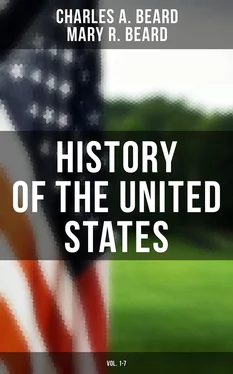The importance of this enterprise to British economic life can hardly be overestimated. For many a century the English had employed their fine woolen cloth as the chief staple in a lucrative foreign trade, and the government had come to look upon it as an object of special interest and protection. When the colonies were established, both merchants and statesmen naturally expected to maintain a monopoly of increasing value; but before long the Americans, instead of buying cloth, especially of the coarser varieties, were making it to sell. In the place of customers, here were rivals. In the place of helpless reliance upon English markets, here was the germ of economic independence.
If British merchants had not discovered it in the ordinary course of trade, observant officers in the provinces would have conveyed the news to them. Even in the early years of the eighteenth century the royal governor of New York wrote of the industrious Americans to his home government: "The consequence will be that if they can clothe themselves once, not only comfortably, but handsomely too, without the help of England, they who already are not very fond of submitting to government will soon think of putting in execution designs they have long harboured in their breasts. This will not seem strange when you consider what sort of people this country is inhabited by."
The Iron Industry.—Almost equally widespread was the art of iron working—one of the earliest and most picturesque of colonial industries. Lynn, Massachusetts, had a forge and skilled artisans within fifteen years after the founding of Boston. The smelting of iron began at New London and New Haven about 1658; in Litchfield county, Connecticut, a few years later; at Great Barrington, Massachusetts, in 1731; and near by at Lenox some thirty years after that. New Jersey had iron works at Shrewsbury within ten years after the founding of the colony in 1665. Iron forges appeared in the valleys of the Delaware and the Susquehanna early in the following century, and iron masters then laid the foundations of fortunes in a region destined to become one of the great iron centers of the world. Virginia began iron working in the year that saw the introduction of slavery. Although the industry soon lapsed, it was renewed and flourished in the eighteenth century. Governor Spotswood was called the "Tubal Cain" of the Old Dominion because he placed the industry on a firm foundation. Indeed it seems that every colony, except Georgia, had its iron foundry. Nails, wire, metallic ware, chains, anchors, bar and pig iron were made in large quantities; and Great Britain, by an act in 1750, encouraged the colonists to export rough iron to the British Islands.
Shipbuilding.—Of all the specialized industries in the colonies, shipbuilding was the most important. The abundance of fir for masts, oak for timbers and boards, pitch for tar and turpentine, and hemp for rope made the way of the shipbuilder easy. Early in the seventeenth century a ship was built at New Amsterdam, and by the middle of that century shipyards were scattered along the New England coast at Newburyport, Salem, New Bedford, Newport, Providence, New London, and New Haven. Yards at Albany and Poughkeepsie in New York built ships for the trade of that colony with England and the Indies. Wilmington and Philadelphia soon entered the race and outdistanced New York, though unable to equal the pace set by New England. While Maryland, Virginia, and South Carolina also built ships, Southern interest was mainly confined to the lucrative business of producing ship materials: fir, cedar, hemp, and tar.
Fishing.—The greatest single economic resource of New England outside of agriculture was the fisheries. This industry, started by hardy sailors from Europe, long before the landing of the Pilgrims, flourished under the indomitable seamanship of the Puritans, who labored with the net and the harpoon in almost every quarter of the Atlantic. "Look," exclaimed Edmund Burke, in the House of Commons, "at the manner in which the people of New England have of late carried on the whale fishery. Whilst we follow them among the tumbling mountains of ice and behold them penetrating into the deepest frozen recesses of Hudson's Bay and Davis's Straits, while we are looking for them beneath the arctic circle, we hear that they have pierced into the opposite region of polar cold, that they are at the antipodes and engaged under the frozen serpent of the south.... Nor is the equinoctial heat more discouraging to them than the accumulated winter of both poles. We know that, whilst some of them draw the line and strike the harpoon on the coast of Africa, others run the longitude and pursue their gigantic game along the coast of Brazil. No sea but what is vexed by their fisheries. No climate that is not witness to their toils. Neither the perseverance of Holland nor the activity of France nor the dexterous and firm sagacity of English enterprise ever carried this most perilous mode of hard industry to the extent to which it has been pushed by this recent people."
The influence of the business was widespread. A large and lucrative European trade was built upon it. The better quality of the fish caught for food was sold in the markets of Spain, Portugal, and Italy, or exchanged for salt, lemons, and raisins for the American market. The lower grades of fish were carried to the West Indies for slave consumption, and in part traded for sugar and molasses, which furnished the raw materials for the thriving rum industry of New England. These activities, in turn, stimulated shipbuilding, steadily enlarging the demand for fishing and merchant craft of every kind and thus keeping the shipwrights, calkers, rope makers, and other artisans of the seaport towns rushed with work. They also increased trade with the mother country for, out of the cash collected in the fish markets of Europe and the West Indies, the colonists paid for English manufactures. So an ever-widening circle of American enterprise centered around this single industry, the nursery of seamanship and the maritime spirit.
Oceanic Commerce and American Merchants.—All through the eighteenth century, the commerce of the American colonies spread in every direction until it rivaled in the number of people employed, the capital engaged, and the profits gleaned, the commerce of European nations. A modern historian has said: "The enterprising merchants of New England developed a network of trade routes that covered well-nigh half the world." This commerce, destined to be of such significance in the conflict with the mother country, presented, broadly speaking, two aspects.
On the one side, it involved the export of raw materials and agricultural produce. The Southern colonies produced for shipping, tobacco, rice, tar, pitch, and pine; the Middle colonies, grain, flour, furs, lumber, and salt pork; New England, fish, flour, rum, furs, shoes, and small articles of manufacture. The variety of products was in fact astounding. A sarcastic writer, while sneering at the idea of an American union, once remarked of colonial trade: "What sort of dish will you make? New England will throw in fish and onions. The middle states, flax-seed and flour. Maryland and Virginia will add tobacco. North Carolina, pitch, tar, and turpentine. South Carolina, rice and indigo, and Georgia will sprinkle the whole composition with sawdust. Such an absurd jumble will you make if you attempt to form a union among such discordant materials as the thirteen British provinces."
On the other side, American commerce involved the import trade, consisting principally of English and continental manufactures, tea, and "India goods." Sugar and molasses, brought from the West Indies, supplied the flourishing distilleries of Massachusetts, Rhode Island, and Connecticut. The carriage of slaves from Africa to the Southern colonies engaged hundreds of New England's sailors and thousands of pounds of her capital.
Читать дальше












